
Yes, one sees them now in supermarkets, bright red, big-bosomed fruits piled high in plastic boxes luring us to a summer fantasy but delivering pithy white centers and a taste only reminiscent of strawberries. If you want the real thing in abundance, plant now.
Nurseries have them in stock, some in the traditional tight rubber-banded bundles of ten, dormant and nestled in damp sawdust, for ten dollars; others, to my surprise, offer individual rooted plants for four or five dollars apiece. Right off you must make a basic choice and go for either June-bearing varieties such as Rainer, Benton, and Hood or the so-called Everlasting, or Day-neutral varieties such as Seascape, Tri-star, or Albion. Perhaps you will want a row of each.
June-bearers can count the hours of daylight and time themselves to deliver a big crop in the three or four weeks around mid-summer’s eve, in support of, I suppose, the bacchanalian delights of that ancient holiday. Day-neutrals have been freed from this traditional devotion by smart hybridizers who have somehow turned off their clocks and persuaded them to bear a similar crop but extended over all the days of summer, a few at a time.
Strawberries are cursed with a subtle virus which, over two or three seasons, will gradually reduce their production, so any planting must be pulled out at least every three years and replanted, preferably in a different spot. This is also the reason you should not accept the generous offer of a neighbor of her extras. Nurseries must sell certified virus-free stock, produced by I know-not-what dark means, but always offering a fresh start.
The reason your neighbor has so many extras to offer is in the very female nature of strawberries: each new plant is referred to as a “mother” and right after getting comfortably rooted down will begin producing “daughters” on long arching stems which will root where they land in decent soil. Each mother will have at least five daughters and this is the reason you only need that bundle of ten to start a larger patch.
If you are a laissez-faire gardener let them stay where they land and make a matted patch. Or, snip them off when you see little roots and fill in the in-between spaces you left, on purpose, in your orderly rows. Sadly, there are eventually so many daughters you will have to chop them off and put them on the compost. Also, sadly, you will have to pinch any flowers that appear on your Junies and wait until next year for your first harvest.
The Day-neutral girls must be pinched only until mid-summer when you can begin to enjoy their fruit. If you want jam, freezerfuls and pure abundance, plant Junies or go to the great U-picks in Sequim. Each plant will give you about a quart. If you want enough for your Cheerios in the morning or strawberry shortcake for dessert, you can count on about the same yield, over the season, from the Day-neutrals.

One of the joys of gardening in the PNW is berries of all sorts – our conditions are perfect for them. Witness the impenetrable sprawl of blackberries, both Himalayan and native, on roadsides and “waste” places anywhere around here that has a little extra moisture. Bainbridge Island gets a little more rain than we do and was once famous for its strawberries.
Japanese-American farmers pioneered strawberry planting there, eventually needing a processing plant where 700 iced barrels a week were shipped from local docks. In 1932 King George V and Queen Elizabeth made a visit to British Colombia and their loyal subjects sent to Bainbridge for the strawberries.
The renowned berry of the time was the June-bearing Marshall, still recalled with longing by the old-timers I knew when I lived there, but it had become inbred and didn’t take to the new freezing technology. Still, wonderful varieties have come along since, especially for the home grower who doesn’t have to give up anything in taste and texture for commercial reasons.
A note of warning, don’t order intriguing varieties from far-away catalogs. Just as they understand day length, strawberries are also aware of latitude (you might wonder if they invented navigation!) and there are many named cultivars. Here you can trust your local nurseries and catalogs to supply the ones that do best in our region.
Next, we must speak to enjoyment. It is very important that you eat as many ripe strawberries as you can; there is cereal and dessert and then there is the best: random grazing. Unlike the poseurs, a ripe home-grown strawberry is not crispy and needn’t be chewed; usually you can simply crush one against the roof of your mouth with your tongue and quiver with delight. Then, perhaps, just one more. You must gorge for the season so that you can sigh, wave good-bye and wait for next year, not in the least tempted by the floozies at the supermarket.
This story first ran in our partner site Rainshadow Northwest, based in Port Townsend

This is one of the tastiest stories I’ve read in a moon’s age. Just to imagine crushing a ripe local berry to the roof of one’s mouth and quivering with delight. Love, too, the caution against the temptation of imports. What does she call them: “floozies at the supermarket.” thank you, master gardener.
As a newbie to published writing I am delighted by your comment. I remember you well from my Seattle (1969 -1973) and Bainbridge Island (1973 – 2002) days when those of us who loved newspapers could still enjoy the P.I. and Times in all their glory. Now I get the local Peninsula Daily News which does a good job covering the north Olympic Peninsula and has a good Crossword.
Thanks for taking the time for your note and know you were important to me, especially in those transition days when it was a novel idea that women’s voices could be heard. Thanks Jean.
Ann